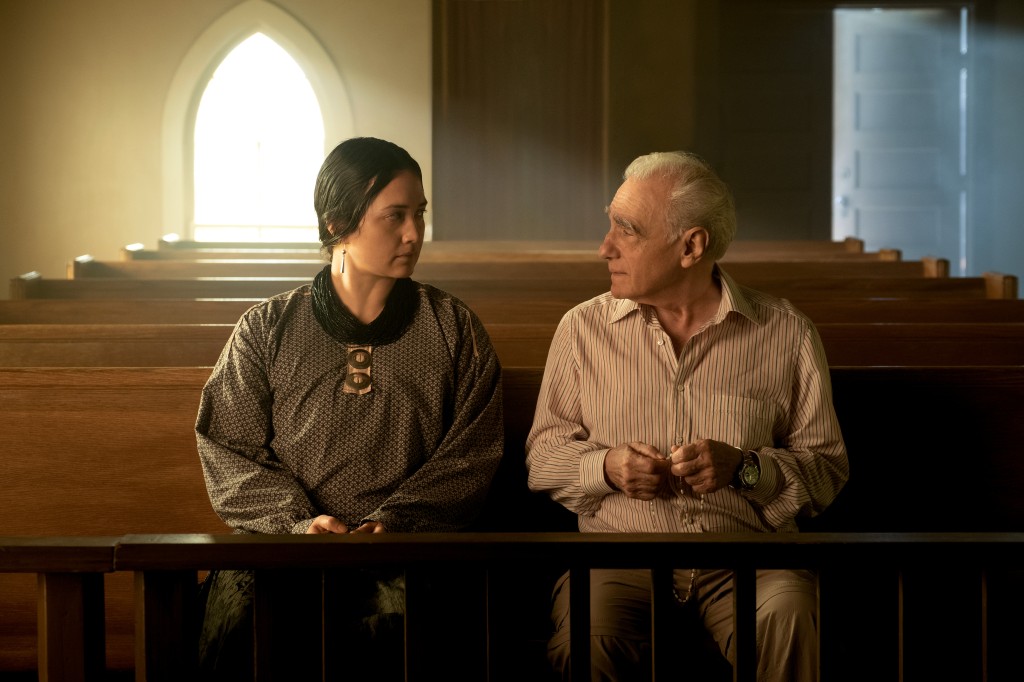
Although Leonardo DiCaprio and Robert De Niro take top billing in Martin Scorsese’s harrowing drama, one might say the real star of Killers of the Flower Moon is a relative unknown: Lily Gladstone, who plays Mollie, wife to DiCaprio’s Ernest. Mollie is the film’s conscience, a rich Osage woman who is slowly being robbed of her health by a seemingly simple case of diabetes. Insulin shots only seem to make matters worse, and after losing her sisters in suspicious circumstances, Mollie insists that only her husband can administer her medicine. But is she being too trusting?
An American actress of Blackfeet and Nimíipuu heritage, Gladstone came to Scorsese’s attention after he saw her in Kelly Reichardt’s Certain Women. In an ensemble cast including Michelle Williams, Kristen Stewart and Laura Dern, she more than held her own, prompting Rolling Stone’s review to enthuse that “Gladstone gives a performance of such piercing honesty and yearning, you almost can’t look at her.” So, it’s hardly a stretch to suggest that Scorsese’s film might take her all the way from Cannes to the Oscars.
Lily Gladstone
Arturo Holmes/Getty Images
Growing up in Montana, Gladstone recalls hearing stories about the exploitation of the Osage. “I didn’t have language for it being the reign of terror, until David Grann’s book reached the cultural zeitgeist,” she says. “I was aware of it in passing from my dad when I homeschooled in fifth grade. He told me about how Osages were killed for having oil money. I remember being upset about it, and then I would hear Osage stories make the rounds across Indian country. My father joked about how he’d heard that Osages had so much money they would buy a Rolls Royce, and when it ran out of gas, they’d go, ‘Oh well, I guess it’s time for another one.’ And then they’d go buy another car.”
She continues: “It’s a funny story, until you think about the implications. You had all these people who moved to Osage County to take advantage of this first wave of folks with headrights to oil, at a time when people were moving from a horse cart to driving automobiles. Nobody was going to say to those first generations of Osage, ‘No, you just fill the tank up with gas.’ All these people set up businesses around Osage wealth. Grann mentions it in the book, and this is something that a lot of families talked about, how there was this ‘Osage tax’, which meant things were horribly overpriced.”
Although some dramatic license has been taken, Gladstone believes that the version of events presented in Killers of the Flower Moon is true, and that attention to the fil will help the Osage’s claims that their land and fortunes were stolen, either literally, or, more chillingly, by white “guardians” appointed to oversee Osage tribe members’ money and limit their access to it. Gladstone’s research included the novel A Pipe for February by Charles H. Red Corn, which offered an Osage perspective on what happened to them and their rising levels of paranoia. “It’s a beautiful book,” she says.
But instead of talking history, Scorsese and DiCaprio wanted to talk to Gladstone about the moral aspects of the story. “Marty and Leo had conversations with me about what the nature of evil is, and how evil doesn’t see itself as evil,” she remembers. “Can somebody really love and honor another, feel all these things in one aspect of their psyche, and then turn around and do all of these other hateful, evil, entitled things? The tightrope walk was exploring the relationship between Ernest and Mollie.”

Read the digital edition of Deadline’s Disruptors/Cannes magazine here.
She says playing Mollie helped her understand the structures of Osage society. “The Osage are a patriarchal society only in the sense that men are the ones who get up and speak and kind of represent the family,” she explains. “But the women own everything, and when families come together, it’s really around the woman. She grounds everything, and I can see Mollie having that view of herself, coming from a tradition of women really being the heart of everything, and being the backbone.”
That insight made it easier for her to navigate the relationship. “The Mollie that I found loved Ernest for the innocence that she saw there,” she says, “which is something that can resonate with lots of women: loving that hurt little boy. If you do that, if you don’t think somebody can do something so calculated and evil, then they can. Right under your nose. I could see the tightrope Leo was walking. Ernest was receiving love and acceptance from Mollie, and yet there were other loyalties in his life.”














